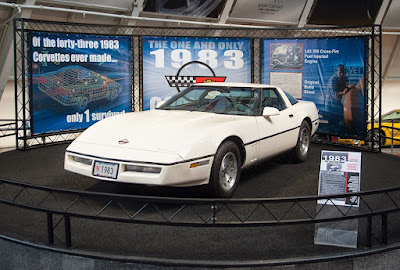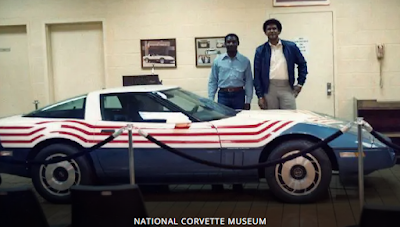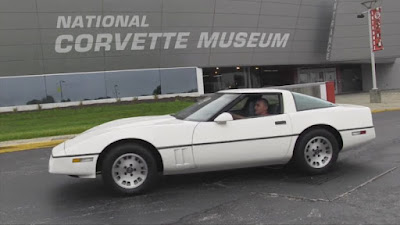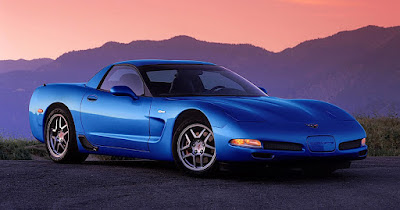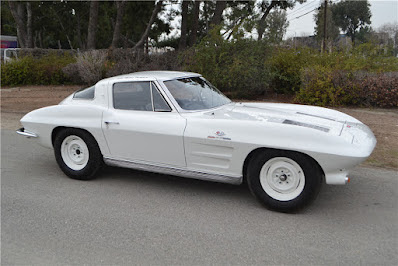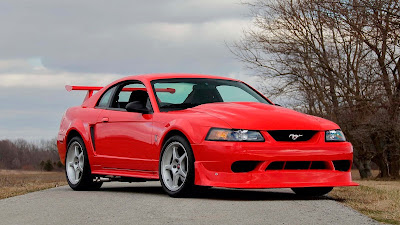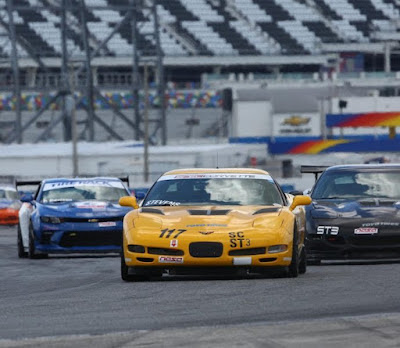The 1969 Chevrolet Nova 427 Yenko/SC, also known as the Super Nova, is said to be the rarest and fastest Yenko vehicle ever built. With only 37 of these bad boys being sold from Don Yenko's dealership, there are only about 7-10 left known to be in existence today.
General Motors High-Performance Blog
Saturday, June 21, 2025
1969 Chevrolet Nova Yenko/SC: Fastest and Rarest of All Yenko Vehicles
Friday, June 6, 2025
Own A '63 Corvette Grand Sport Without Paying Millions
Rare Corvettes for Less
Some of the rarest sports cars of all time are a group of five early '60s Corvette Grand Sports built with the sole purpose of running in the GT classes at the Sebring 12 Hours and the 24-hour LaMans races.
The Godfather of Corvettes, Zora Arkus-Duntov, led the crusade of light-weight race-ready roadsters that were designed to compete with the dominant Ford GTs and the rest of the field's competitors.
Duntov had planned on building 1,000 of these Corvettes, but only five Corvette Grand Sports were originally built in the ‘60s.
Two of the Corvettes [#001 and #002] were put to the side and three others were sent to John Mecom of Houston, TX, who eventually sent them off to three other prominent individuals in the racing industry.
Purchasing One Of These Rare Beauties
So let's say you were not lucky enough to be one of those people who received one of those five Corvettes, but now you would like to see if you can purchase one today.
Well, although these Corvettes are not relevant in the 24-hour LaMans and other races anymore, fat chance of getting your hands on one for under five million dollars.
A few years back, the #002 Corvette Grand Sport found its way to an auction block, and although the high bid was $4.9 million, it was still not enough to take the blue beautiful race car home.
If you're like most car guys, you probably don't have $4.9 million sitting around for a sports car that you wouldn't even want to drive that much anyway. But getting something similar and in many cases, much more modern and driveable with an affordable price tag is definitely feasible.
Superformance, a car-building company in Southern California pushed to get granted the licensing to build replicas of Zora Duntov’s famed Corvette Grand Sport making it possible to own one, well at least a replica of one.
Superformance was even granted original build sheets for the #002 Grand Sport Corvette. They claim that if you wanted a replica almost identical to the original, they could build you one that only experts could tell it’s not an original #002 Grand Sport.
But like a lot of people, you're probably just looking for the look of the legendary Corvette and the performance and comforts of a newer vehicle and that's fine, Superformance is dedicated to building Vettes like that.
Customize Your Own Corvette Grand Sport
Superformance will work you up a vintage Corvette Grand Sport of your liking. Features like power steering, four-wheel disc brakes, power windows, A/C, and fully independent front and rear suspension with Bilstein suspension components can be optioned up for your Vette. There are roadster versions available, but they will look and drive more like the race Corvettes of the past, and many features and options of the coupe will be limited. But as far as power plants go, Superformance offers a variety of engines including an LS9 supercharged monster that can really make the coupe and the roadsters fun to drive.
There are actually seven engines in all to choose from. All engines come with a 2/year 50,000-mile warranty that can be serviced at your local authorized dealer. The greatest thing about the Superformance Corvette Grand Sport replica is the price tag.
Sunday, February 23, 2025
Best Car Cruising Movie of All Time "American Graffiti"
A Movie That Emulates a Great Time in Car
History!
The Changing of a Car Cursing Generation
What's Coming New Look for The Car Curing Scene?
What Happen to the Illeage Drag Racing Scene?
"American Graffiti" The Grooming of Some Great Actors
.
A Great Movie for a Great Time in American History
We Need To Get Back To This Type Of Fun
Tuesday, February 4, 2025
First 1967 Camaro Commercial Broadcast In 1966
Back in 1966, the American people were introduced to a sports car that would see five decades of success. That sports car was the Camaro, and to this day has just as much power and influence in the high-performance auto motor industry as the day it first went on sale on Sept. 29, 1966.
After the Mustang was introduced in 1964, Chevrolet had to come up with a sportier, tougher two-door sports car than its current two-door sports car at the time, the Corvair. So under the code name XP-836 and then soon after named the Panther for temporary identification, Chevy went to work.
For the year 1967, Chevy decided to name the soon-to-be iconic sports car, the "Camaro". This obscure word comes from the French-English dictionary meaning "friend". They added eight different engine setups including a SS 350 option and a stout 427 option. Even though the Z/28 did not come along till the next year, on the day of September 29th, 1966, the Camaro hit the road for the first time. Five decades later, this sports car is still a noticeable piece of automobile history no matter what year or model you are driving.
Sunday, May 26, 2024
Indianapolis 500 Corvette E-Ray Pace Car And The Rest Of The Corvettes That Served Indy
Sunday, May 26, 2024, we will once again see a Corvette running laps as a pace car for the Indianapolis 500. But this won't be just any Corvette—it is Corvette's first all-new 2024 Corvette ELZ E-Rayall-new 2024 Corvette ELZ E-Ray.
This is Corvette's 21st time pacing the Indy 500 since 1978, more than any other car in history. If you add that up with all 35 appearances of Chevorlets that paced the event since 1948, Chevy is by far the leader for this honor.
How Does The E-Ray Corvette Stack Up To Its Syblines?
The Electric All-Wheel Drive (eAWD) E-Ray is the quickest production Corvette that has ever come off the assembly line at the Corvette Plant in Bowling Green, KY.
Using a 6.2-liter powerhouse V8 running6.2-liter powerhouse V8 running in tandem with an electric motor that adds an additional 160 horsepower and 125 lb.-ft. of torque to the front wheels, this Corvette is good for 655 combined horsepower.
What do these numbers mean while the Corvette is in motion? How about a 0-60 MPH time in just 2.5 seconds, and if you decide to keep the pedal to the metal, you'll cover the quarter-mile track in just 10.5 seconds. The E-Ray can also drive on its electric motor alone for up to 4 miles at 45 MPH when Stealth Mode is selected.
Who's Going To Be Driving The E-Ray Pace Car?
Piloting the E-Ray at the Indy 500 is going to a famous former MLB outfielder, All-Star, Ken Griffey Jr.All-Star, Ken Griffey Jr. If you haven't heard of this guy, even if you don't watch sport, you must have been living under a rock for the 35 years. All you have to do is punch his name into a search engine, and you'll see the mountain of awards and accomplishments he has made—Golden Glove Awards, All-Star awards, hitting awards, and more.
Here's A Run Down Of The Past Corvettes To Take The Indy Honor
1. May 26, 1978, the 62nd Annual Indianapolis 500 is the first time Corvette graces Indy fans with its presence. Driven by American race car driver Jim Rathmann.
3. May 28, 1995, the 79th running of the Indianapolis 500, brought to the stage one of the more colorful Corvette Pace Cars. This 1995 Corvette Pace Car version was raced equipped with a five-point safety harness, an onboard fire suppression system, a special "halo" roll-bar, and a special strobe light setup for more eye appeal. For this year the Corvette was driven by former Chevrolet Manager Jim Perkins.
10. May 25, 2008, the 92nd running of the Indianapolis 500 would see two pace cars for the first time. First, there was a 2008 Corvette Z06 engineered to run off of E85 Ethanol fuel. And then there was another pace car dressed in a black and silver color scheme to celebrate the anniversary of the first Corvette Indy 500 car that debuted 30 years earlier. These pace cars would be driven by celebrity race car driver Emerson Fittipaldi.
11. After a little break from the action, Corvette returns to Indy. May 27, 2012, the 96th running of the Indianapolis 500 saw its first 6th-generation ZR1. This car took Americans by storm with its supercar-like performance. Famous Emmy Award-winning television cook and personality received the honor of driving this LS9 powerhouse around the track—too bad he wasn't able to reach its top speed of 205 MPH at pace mode.
12. May 26, 2013, the 97th running of the Indy 500 brought onboard the all-new seventh-generation Corvette Stingray. San Francisco 49ers head coach, Jim Harbaugh was asked to take on the pace car duties for the year, he happily obliged.
13. May 24, 2015, the 99th running of the Indianapolis 500 would bring a superstar race car driver from NASCAR on board to pilot the 2015 Corvette Z06 Pace Car. Jeff Gordon won his first NASCAR race in Indianapolis before going on to become a legend in the sport. Although he won't be going as fast as he's used to on the track, this supercharged 550 horsepower sports car is certainly capable of high speeds.
14. May 28, 2017, was the first year where the Indy 500 Corvette Pace Car would not change much in the way of a color scheme from the year before, but the Vette was different. This year for the 101st running of the Indianapolis 500, Corvette debuted its new 2017 Corvette Grand Sport. Actor Jeffrey Dean Morgan seat behind the wheel and paced the Indy Car field around the famous track.
15. May 27, 2018, the 102nd Indianapolis 500 pace car would be another ZR1, but this 2019 Corvette ZR1 would boast 755 horsepower, get a 0-60 time of 2.85 seconds, and reach a top speed of 212 MPH. This powerful supercharged Corvette would be driven by Victor Oladipo, an Indiana University and Indiana Pacers basketball player.
16. May 26, 2019, the 103rd running of the Indianapolis 500 would see another 2019 version of the Corvette as a Pace Car. Following the previous year's '19 ZR1 pace car, the Corvette Grand Sport would take center stage for pace car duties. Getting to have some non-competitive fun on the track would be Dale Earnhardt Jr. pacing the Indy Car field.
17. On to the unveiling of the mid-engine Corvette. It was a long-time conversion in the makings, and that made it an obvious choice to become the official Pace Car for the 2020 Indianapolis 500. GM President Mark Reuss was honored to be the driver who got to pace the track for this Indy 500.
18. May 30, 2021, the 105th Inianaplos 500 adopts another mid-engine Corvette for pace car duties. Its white exterior color with yellow accents and black rims, makes the Corvette stand out. Chosen to take this beautiful ride around the track is the beautiful and most successful open-wheel racer in history, Danica Patrick.
19. May 29, 2022, this 106th running of the Indianapolis 500 would bring you a masterpiece 2023 Corvette Z06. This 70th-anniversary Vette was complemented with a naturally-aspirated flat-crank 5.5-liter V8. This sports car was a beast all of its own. Chosen to pilot this Corvette was former Indy Car driver and three-time podium-finisher Sarah Fisher.
20. May 28, 2023, Corvette paced the Indianapolis 500 with their first-ever convertible hard-top Z06first-ever convertible hard-top Z06. This badass-looking ride is something anyone can fall in love with. So who gets to drive this fine sports car on the big day? Tyrese Haliburton, an Indian Paces basketball point guard.
Monday, May 13, 2024
1983 Corvette C4: Only One In Existence
1983 C4 Corvette
Thursday, May 2, 2024
2001 Corvette Z06: The First Modern Day Z06
Unless you've been living under a rock, you know about the extremely potent 2023 Corvette Z06 that is on its way to the market sometime in late 2022. If you want to read about that, just look up any automotive website on the web and you can find out everything you know or you can go to this ride-along video/article with top engineers on the project, written by me for Muscle Cars & Trucks (C8 Corvette Z06 Engineers Share Untold Details On New Supercar: Video.
1963 Corvette Z06
Since we all should know everything about the new Corvette Z06, I decided that we should take a look back at the birth of the first modern Corvette Z06. But first, let's take a short look at the birth of the very first Z06.
The first Z06 became available in 1963 and there were only 199 produced and sold. These Corvette Z06's sole purpose was to be sold for road course racing. They came with a 327 cu.in. (5.4-liter) engine, four-speed transmission, a beefed-up suspension, a massive brake system upgrade that included dual master cylinders, and an optional 36.5 US gal (138 l; 30 imp gal) tank.
The thing about these C2 Corvette Z06s was you didn't just go to the dealership and buy one, you had to know someone who knew what boxes to check in the order form if you wanted one of these race-ready (RPO Z06) Corvettes, and just like the 2001 Corvette Z06, you didn't get many luxuries with the car, it was truly for going fast.
2021 Corvette Z06
This Corvette was built to surprise and dominate the market. The Z06 was designed for the track and pushed the boundaries of what was really possible from a production car that could drive to the track, make better times than its competition, and drive back home with the air conditioning kicking and the radio blasting.
Basic Spec:
- 5.7-liter LS6 V8
- 6-speed manual
- 385 horsepower and 385 lb-ft of torque
- New FE4 Suspension (four-wheel independent suspension)
- Bose speaker system
- Leather bucket seats
- 17" front and 18” rear rims wrapped in Goodyear Eagle F1 SC tires
- Hardtop only
- Brake coolers
- Curb weight: 3,118 lbs.
- Gas Mileage: 17 City / 26 highway
Engine And Transmission
The LS6 is essentially a more powerful version of Corvette's LS1 V8. The LS6 engine upgrades start with a redesigned intake manifold with better-flowing internal passageways. Reengineered cylinder heads create more flow through the intake and exhaust valves, and the combustion chambers were redesigned to reduce valve shrouding.
All these upgrades led to a higher compression ratio which then led to a redesigned thin-walled cast-iron exhaust manifold system to provide a smoother exit for the combustion escape.
Of course, all this extra flow wouldn’t be worth much without a redesigned camshaft. So a beefier cam was installed by Corvette engineers with more valve overlap and greater valve lift. Chrome-vanadium-steel valve springs and stronger pistons cast from a more durable alloy were implicated in the engine’s design for toughness. And finally, the LS6 was engineered with windows cast into the internal crankcase walls to help air retreat from the underside of the burning hot pistons.
This new engine setup gave the New Corvette Z06 385 horsepower at 6,000 RPMs and 385 lb-ft of torque at 4,800 RPMs, and a redline RPM of 6,500. In between all the power and the rear wheels was a beefed-up clutch (with lighter pedal effort), a larger-diameter driveshaft, and a revised six-speed manual transaxle. This new M12 gearbox was introduced with shooter 1st, 2nd, and 3rd gears to better utilize the new higher-revving LS6. All gears were 10-16 percent shorter except for the 4th gear which remained the same.
2001 Corvette Z06 Suspension
More power always means more changes all around. To accommodate the power of the LS6, Corvette went with a new FE4 suspension that included revised shock calibrations, a stiffer rear transverse leaf spring setup, and stiffer anti-roll bars for the front and rear.
To add ground support, each corner of the Vette receives 1-inch wider tires, bringing them up to 9.5-inch wide in the front and 10.5-inch wide in the back. New custom light-weight 10-spoke wheels were wrapped in Goodyear F1 Eagle tires: 265/40ZR-17s in the front and 295/35ZR-18s rears. The F1 Eagle SC tires were designed with more flexible sidewalls achieved by doing away with the famous run-flat tire design. This permitted a half-degree more negative camber to keep the tread flatter during hard cornering for track use.
To prove the Corvette was built for business, engineers found places around the car where they could shave pounds off the curb weight. Helping save weight was the deletion of the run-flat tire design, mufflers were made from Titanium, and the windshield and rear glass were all lightened to help bring the Corvette’s curb weight down to 3,118 pounds, that is 38 pounds lighter than its original form. A lot of weight was saved in the Titanium mufflers alone, but the weight of the new suspension offset the weight-saving by a lot.
Step Aside Cobra R
The Cobra R was making some big waves at the track. Performance numbers were pretty impressive, and the Corvette Z06 was Chevrolet's answer to those performance numbers.
The Cobra R and the Z06 were pretty close in performance numbers at the time (numbers for Z06 below). The Cobra R turned numbers out of its 5.4-liter that looked a little like this: 385 horsepower and 385 lb.-ft. of torque (the same as the Z06), 0-60 mph in 4.7 seconds, a quarter-mile time of 13.2 (Ford tested) and 12.9 (Motor Trend tested) with a top speed of 170 mph, and stops from 60-0 in 127 feet.
Although the numbers were somewhat close, the Corvette beat out the Cobra R in other places. The Cobra R lacked air conditioning, an audio system, rear seats, sound dampening, and cruise control. The Corvette also lacked a back seat, but that's because it was never meant to have one, it wasn't a compromise. Also, because of the limited number of Cobra Rs that were built, the sticker price showed $55,5ish, but you couldn't buy one for under $75,000. The Corvette Z06 stuck pretty close to its price tag of just under $50,000 without a lot of limited edition inflation.
Let's Go Over Some 2001 Corvette Z06 Numbers
The 2001 Corvette Z06's proof of superiority is in the numbers. A 0-60-mph time is recorded at 4.3 seconds, and a 70-mph to 0 stop takes only 152 feet. In a quarter-mile sprint, the Corvette can cover it in 12.7 seconds at 113 mph. Hitting 150 mph will only take you 28 seconds total, while a top speed of 170 mph is easily manageable. Although the top speed does suffer a little bit as the C5 Vettes will hit 175 mph, that's because of the Z06's closer transmission clutch gear ratios.
Hitting corners is another place where the Corvette Z06 shows no mercy to its competitors. Pulling .98 Gs in and out of corners is just what this sports car does, and that actually beats out all other sports cars out of there including the Viper GTS and the Ferrari 360 Modena, which are above the Corvette Z06s price bracket by a lot.
Z06 Performance Built
Making sure everything was performance-built was what this Corvette was all about, even both the dual mesh grilles in the front and the rear brake coolers in front of the rear wheel wells are completely functional.
The 2001 Corvette Z06 is just like the new Z06s, although classified as a sports car, they perform like a supercar compared to its competition.



























